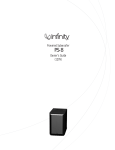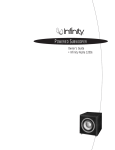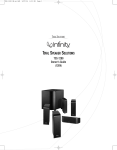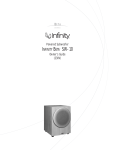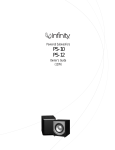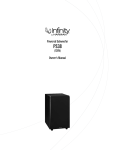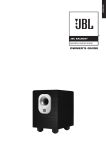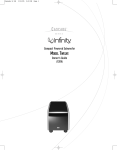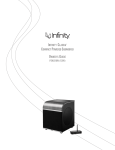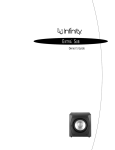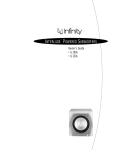Download Infinity Entra Sub Two Speaker
Transcript
® ENTRA SUB TWO Owner’s Guide IMPORTANT SAFETY PRECAUTIONS Read First! CAUTION RISK OF ELECTRIC SHOCK DO NOT OPEN CAUTION: To prevent electric shock, do not use this (polarized) plug with an extension cord, receptacle or other outlet unless the blades can be fully inserted to prevent blade exposure. The lightning flash with arrowhead symbol, within an equilateral triangle, is intended to alert the user to the presence of uninsulated “dangerous voltage” within the product’s enclosure that may be of sufficient magnitude to constitute a risk of electric shock to persons. The exclamation point within an equilateral triangle is intended to alert the user to the presence of important operating and maintenance (servicing) instructions in the literature accompanying the appliance. 1. Read Instructions. All the safety and operating instructions should be read before the product is operated. 2. Retain Instructions. The safety and operating instructions should be retained for future reference. 3. Heed Warnings. All warnings on the product and in the operating instructions should be adhered to. 4. Follow Instructions. All operating and use instructions should be followed. 5. Cleaning. Unplug this product from the wall outlet before cleaning. Do not use liquid cleaners or aerosol cleaners. Use a damp cloth for cleaning. 6. Attachments. Do not use attachments not recommended by the product manufacturer, as they may cause hazards. 7. Water and Moisture. To reduce the risk of fire or electric shock, do not use this product outdoors or near water–for example, near a bathtub, wash bowl, kitchen sink or laundry tub; in a wet basement; near a swimming pool; or the like. 8. Accessories. Do not place this product on an unstable cart, stand, tripod, bracket or table.The product may fall, causing serious injury to a child or adult, and serious damage to the product. Use only with a cart, stand, tripod, bracket or table recommended by the manufacturer, or sold with the product. Any mounting of the product should follow the manufacturer’s instructions, and should use a mounting accessory recommended by the manufacturer. 9. A Product and Cart Combination Should Be Moved with Care. Quick stops, excessive force and uneven surfaces may cause the product and cart combination to overturn. 10. Ventilation. Slots and openings in the cabinet are provided for ventilation and to ensure reliable operation of the product and to protect it from overheating, and these openings must not be blocked or covered.The openings should never be blocked by placing the product on a bed, sofa, rug or other similar surface.This product should not be placed in a built-in installation, such as a bookcase or rack, ii ENTRA SUB TWO unless proper ventilation is provided or the manufacturer’s instructions have been adhered to. 11. Power Sources. This product should be operated only from the type of power source indicated on the marking label. If you are not sure of the type of power supply to your home, consult your product dealer or local power company. For products intended to operate from battery power, or other sources, refer to the operating instructions. 12. Grounding or Polarization. This product may be equipped with a polarized alternating-current-line plug (a plug having one blade wider than the other).This plug will fit into the power outlet only one way.This is a safety feature. If you are unable to insert the plug fully into the outlet, try reversing the plug. If the plug should still fail to fit, contact your electrician to replace your obsolete outlet. Do not defeat the safety purpose of the polarized plug. 13. Power-Cord Protection. Power-supply cords should be routed so that they are not likely to be walked on or pinched by items placed upon or against them, paying particular attention to cords at plugs, convenience receptacles, and the point where they exit from the product. 14. Nonuse Periods. The power cord of the product should be unplugged from the outlet when left unused for long periods of time. 15. Outdoor Antenna Grounding. If an outside antenna or cable system is connected to the product, be sure the antenna or cable system is grounded so as to provide some protection against voltage surges and built-up static charges. Article 810 of the National Electrical Code, ANSI/NFPA 70, provides information with regard to proper grounding of the mast and supporting structure, grounding of the lead-in wire to an antenna discharge unit, size of grounding conductors, location of antenna-discharge unit, connection to grounding electrodes, and requirements for the grounding electrode. See Figure A. 16. Lightning. For added protection for this product during a lightning storm, or when it is left unattended and unused for long periods of time, unplug it from the wall outlet and disconnect the antenna or cable system.This will prevent damage to the product due to lightning and power-line surges. 17. Power Lines. An outside antenna system should not be located in the vicinity of overhead power lines or other electric light or power circuits, or where it can fall into such power lines or circuits. When installing an outside antenna system, extreme care should be Figure A. Example of Antenna Grounding as per National Electrical Code ANSI/NFPA 70 taken to keep from touching such power lines or circuits, as contact with them might be fatal. 18. Overloading. Do not overload wall outlets, extension cords, or integral convenience receptacles, as this can result in a risk of fire or electric shock. 19. Object and Liquid Entry. Never push objects of any kind into this product through openings, as they may touch dangerous voltage points or short-out parts that could result in a fire or electric shock. Never spill liquid of any kind on the product. 20. Servicing. Do not attempt to service this product yourself, as opening or removing covers may expose you to dangerous voltage or other hazards. Refer all servicing to qualified service personnel. 21. Damage Requiring Service. Unplug this product from the wall outlet and refer servicing to qualified service personnel under the following conditions: a. The power-supply cord or the plug has been damaged; or b. Objects have fallen onto, or liquid has been spilled into, the product; or c. The product has been exposed to rain or water; or d. The product does not operate normally when following the operating instructions. Adjust only those controls that are covered by the operating instructions, as an improper adjustment of other controls may result in damage and will often require extensive work by a qualified technician to restore the product to its normal operation; or e. The product has been dropped or damaged in any way; or f. The product exhibits a distinct change in performance; this indicates a need for service. 22. Replacement Parts. When replacement parts are required, be sure the service technician has used replacement parts specified by the manufacturer or that have the same characteristics as the original part. Unauthorized substitutions may result in fire, electric shock or other hazards. 23. Safety Check. Upon completion of any service or repairs to this product, ask the service technician to perform safety checks to determine that the product is in proper operating condition. 24. Wall or Ceiling Mounting. The product should be mounted to a wall or ceiling only as recommended by the manufacturer. 25. Heat. The product should be situated away from heat sources such as radiators, heat registers, stoves or other products (including amplifiers) that produce heat. Antenna Lead-In Wire Ground Clamp Antenna Discharge Unit (NEC Section 810-20) Grounding Conductors (NEC Section 810-21) Electric Service Equipment Ground Clamps Power Service Grounding Electrode System (NEC Art. 250, Part H) Infinity Entra Series The Entra series of loudspeakers and powered subwoofers continues Infinity’s longstanding commitment to accurate sound reproduction. Our patented Ceramic Metal Matrix Diaphragm™ (C.M.M.D.™) drivers, along with precision dividing networks and rigid, well-braced enclosures, deliver uncompromised performance in any stereo or multichannel home theater. Unpacking the Subwoofer If you suspect damage from transit, report it immediately to your dealer. Keep the shipping carton and packing materials for future use. PLACEMENT Since the installation of a subwoofer can be somewhat more complicated than installing full-range speakers, it is essential that you read this section very carefully prior to connecting the subwoofer to your system. Should you have questions relating to your installation, it is advisable to call either your dealer or Infinity’s Customer Service Department for advice. The performance of the subwoofer is directly related to its placement in the listening room and how you align the subwoofer with its satellite speakers. Setting the volume of the subwoofer in relationship to the left and right speakers is also of critical importance because it is essential that the subwoofer integrate smoothly with the entire system. Setting the subwoofer’s volume level too high will result in an overpowering, boomy bass. Setting the volume level too low will negate the benefits of the subwoofer. Here are several additional facts on installation that may prove useful. It is generally believed by most audio authorities that low frequencies (below 125Hz) are nondirectional and, therefore, placement of a subwoofer within any listening room is not critical. While in theory it is true that the larger wavelengths of extremely low frequencies are basically nondirectional, the fact is that, when installing a subwoofer within the limited confines of a room, reflections, standing waves and absorptions generated within the room will strongly influence the performance of any subwoofer system. As a result, specific location of the subwoofer becomes important, and we strongly recommend that you experiment with placement before choosing a final location. SUB RIGHTCHANNEL SPEAKER PRIMARY LISTENING AREA Figure 1.This example shows the subwoofer positioned behind the right-channel satellite speaker to re-create the actual location of bass instruments in an orchestra and/or add impact to movie soundtracks. Placement will depend upon your room and the amount and quality of bass required (for example, whether or not your room permits placement of the subwoofer near either satellite). Be sure to leave a minimum of six inches between the wall and the port on the subwoofer. ENTRA SUB TWO 1 CONTROLS AND CONNECTIONS Rear Panel ª ¡ LEVEL Green: On Red: Stand-By Line/LFE Selector Max Min LFE PHASE NORMAL 0º Subwoofer-Level Control 180º ™ £ Phase Switch Crossover Frequency Control 80Hz ¢ CROSSOVER FREQUENCY 150Hz 50Hz Line-Level/LFE Input High Speaker-Level Inputs High Speaker-Level Outputs L R ∞ LINE LEVEL IN For LFE use L or R L HIGH LEVEL IN + – § R L HIGH LEVEL OUT ¶ R ON OFF POWER 120V 60Hz Entra Sub Two CAUTION RISK OF ELECTRIC SHOCK DO NOT OPEN WARNING: TO REDUCE THE RISK OF FIRE OR ELECTRICAL SHOCK DO NOT EXPOSE THIS APPLIANCE TO RAIN OR MOISTURE. AVERTISSEMENT: NRTL/C CSA 22.2 UL1492 POUR PR VENIR LES RISQUES D’INCENDIE OU DE CHOC LECTRIQUE, VITER D’EXPOSER CET APPAREIL A LA PLUIE OU A L’HUMIDIT . 2 ENTRA SUB TWO • Power Switch Status LED SYSTEM CONNECTIONS If your receiver/processor does not have subwoofer outputs for the left and right channels or an LFE output: If you have a Dolby* Digital or DTS® receiver/processor with a low-frequency-effect (LFE) or subwoofer output: SUBWOOFER OR LFE OUTPUT LEVEL Green: On Red: Stand-By Max Min LFE NORMAL LEVEL PHASE 0º Green: On Red: Stand-By 180º Max Min 80Hz RECEIVER/AMPLIFIER Front Speaker Output LFE CROSSOVER FREQUENCY PHASE 150Hz 50Hz L NORMAL 0º 180º 80Hz CROSSOVER FREQUENCY R 150Hz 50Hz LINE LEVEL IN For LFE use L or R L L HIGH LEVEL IN + – R LINE LEVEL IN For LFE use L or R R Set line-level/LFE switch to “LFE.” L HIGH LEVEL OUT R ON OFF POWER 120V 60Hz If your receiver/processor does not contain a Dolby Digital or DTS processor but has a subwoofer output: RECEIVER/PROCESSOR LEVEL Entra Sub Two Green: On Red: Stand-By Max Min LFE CAUTION RISK OF ELECTRIC SHOCK DO NOT OPEN WARNING: TO REDUCE THE RISK OF FIRE OR ELECTRICAL SHOCK DO NOT EXPOSE THIS APPLIANCE TO RAIN OR MOISTURE. NTRL/C CSA 22.2 UL1492 L NORMAL R PHASE AVERTISSEMENT: POUR PR VENIR LES RISQUES D’INCENDIE OU DE CHOC LECTRIQUE, VITER D’EXPOSER CET APPAREIL A LA PLUIE OU A L’HUMIDIT . 0º 180º 80Hz CROSSOVER FREQUENCY 150Hz 50Hz RED = + L R LINE LEVEL IN BLACK = – For LFE use L or R 1. LOOSEN TERMINALS L 2. INSERT BARE END; TIGHTEN TERMINALS NO STRIPE = HIGH LEVEL IN – STRIPE = R + Set line-level/LFE switch to “Normal.” This figure shows how to connect bare wires to the terminals. Banana plugs may also be inserted directly into the rear of the connector. NOTE: If your receiver/processor has only one sub out, you may use either the L or R input. ENTRA SUB TWO 3 OPERATION Power On Crossover Adjustments Auto On/Stand-By Low-Pass-Frequency Adjustment control – The Low-Pass control determines the highest frequency at which the subwoofer reproduces sounds. If your main speakers can comfortably reproduce some low-frequency sounds, set this control to a lower frequency setting, between 50Hz – 100Hz.This will concentrate the subwoofer’s efforts on the ultradeep bass sounds required by today’s films and music. If you are using smaller bookshelf speakers that do not extend to the lower bass frequencies, set the Low-Pass Frequency Adjustment control to a higher setting, between 120Hz – 150Hz. RED = STAND-BY (No signal detected, Amp Off) NOTE: This control will have no effect if the Line/LFE Selector is set to “LFE.”If you have a Dolby Digital or DTS processor/receiver, the Low-Pass Frequency is set by the processor/receiver. Consult your owner’s manual to learn how to view or change this setting. Plug your subwoofer’s AC cord into a wall outlet. Do not use the outlets on the back of the receiver. Initially set the subwoofer’s Level control to the “min” position. Turn on your sub by pressing the Power button on the rear panel. Turn on your entire audio system and start a CD or movie soundtrack at a moderate level. With the Power Switch in the ON position, the LED on the back panel will remain lit in red or green to indicate the On/Stand-By mode of the subwoofer. GREEN = ON (Signal detected, Amp On) The subwoofer will automatically enter the Stand-By mode after approximately 10 minutes when no signal is detected from your system.The subwoofer will then power ON instantly when a signal is detected. During periods of normal use, the Power Switch can be left on.You may turn off the Power Switch for extended periods of nonoperation, e.g., when you are away on vacation. Adjust Gain Turn your subwoofer’s Level control up to the “5” position (half way). If no sound emanates from the subwoofer, check the AC-line cord and input cables.Are the connectors on the cables making proper contact? Is the AC plug connected to a “live” receptacle? Has the Power button been pressed to the “On” position? Once you have confirmed that the subwoofer is active, proceed by playing a CD, record or cassette. Use a selection that has ample bass information. Set the overall volume control of the preamplifier or stereo to a comfortable level. Adjust the subwoofer’s Level control until you obtain a pleasing blend of bass. Bass response should not overpower the room but rather be adjusted so there is a harmonious blend across the entire musical range. Many users have a tendency to set the subwoofer volume too loud, adhering to the belief that a subwoofer is there to produce lots of bass.This is not entirely true. A subwoofer is there to enhance bass, extending the response of the entire system so the bass can be felt as well as heard. However, overall balance must be maintained or the music will not sound natural. An experienced listener will set the volume of the subwoofer so its impact on bass response is always there but never obtrusive. Phase Control The Phase switch determines whether the subwoofer speaker’s piston-like action moves in and out with the main speakers, 0˚, or opposite the main speakers, 180˚. Proper phase adjustment depends on several variables such as room size, subwoofer placement and listener position. Adjust the phase switch to maximize bass output at the listening position. 4 ENTRA SUB TWO MAINTENANCE AND SERVICE The enclosure may be cleaned using a soft cloth, dampened with water only, to remove fingerprints or to wipe off dust. The grille may be gently vacuumed. Stains may be removed with an aerosol cleaner, following its instructions. Do not use any solvents on the grille. All wiring connections should be inspected and cleaned or remade periodically.The frequency of maintenance depends on the metals involved in the connections, atmospheric conditions, and other factors, but once per year is the minimum. If a problem occurs, make sure that all connections are properly made and clean. If a problem exists in one loudspeaker, reverse the connection wires to the left and right system. If the problem remains in the same speaker, then the fault is with the loudspeaker. If the problem appears in the opposite speaker, the cause is in another component or cable. In the event that your Entra subwoofer ever needs service, contact your local Infinity dealer or Infinity directly at 1-800-553-3332 or www.infinitysystems.com for a service center near you. SPECIFICATIONS Entra Sub Two Frequency Response: 28Hz – 150Hz (±3dB) Maximum Amplifier Output: 250 watts RMS 500 watts peak (20Hz – 150Hz with no more than 0.1% THD) Crossover Frequencies: 50Hz – 150Hz, 24dB/octave, continuously variable High-Pass Frequency: 150Hz (Speaker-Level Output Only) Driver: 12" C.M.M.D. Dimensions (H x W x D): 17" x 15-3/8" x 19-3/8" (432mm x 391mm x 492mm) Weight: 47 lb (21.4kg) Infinity continually strives to update and improve existing products, as well as create new ones.The specifications and construction details in this and related Infinity publications are therefore subject to change without notice. ENTRA SUB TWO 5 © 2002 Infinity Systems, 250 Crossways Park Drive, Woodbury, NY 11797 USA (800) 553-3332 (USA only) www.infinitysystems.com *Trademark of Dolby Laboratories. DTS is a registered trademark of Digital Theater Systems, Inc. Infinity is a registered trademark and Ceramic Metal Matrix Diaphragm (patent no. 6,327,372) is a trademark of Infinity Systems, Inc. Part No. 336422-004 6/02








